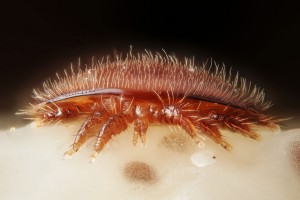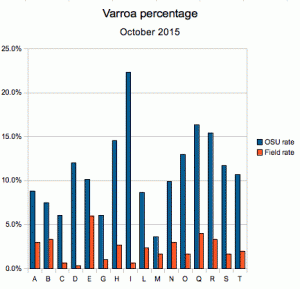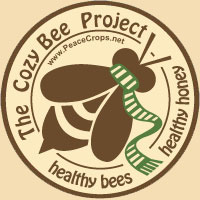First, a little backstory. There has been a problem in beekeeping since the 1980s, causing massive bee die-offs and (back then) prompting fears that bees would go extinct. It’s a parasite by the biological name Varroa destructor, or simply “varroa”. If the name wasn’t a clue as to what is does, it’s a parasite that lives on bees and sucks their blood. They multiply rapidly, our honeybees (Apis mellifera) have no defense against it, and if left unchecked it will destroy a colony in a year or two. It’s thought that it got into our hemisphere a few dacades ago from asia via a bee shipment, and in the years since, has killed 98% of wild honeybee colonies in north america.
 The good news is that if beekeepers are really vigilant, manage their colonies carefully, and treat with miticidal agents, we’ve taken the loss levels down to about 30%-32% annually. That still sounds pretty dire, but by splitting hives in the spring to recoup the losses, it is sustainable for now. The big research effort in beekeeping today is to breed bees that are capable of battling this pest on their own. Some asian species of bees do fine against it, but they don’t produce any honey for humans!
The good news is that if beekeepers are really vigilant, manage their colonies carefully, and treat with miticidal agents, we’ve taken the loss levels down to about 30%-32% annually. That still sounds pretty dire, but by splitting hives in the spring to recoup the losses, it is sustainable for now. The big research effort in beekeeping today is to breed bees that are capable of battling this pest on their own. Some asian species of bees do fine against it, but they don’t produce any honey for humans!
As part of handling Varroa, beekeepers are encouraged to sample their colonies for infestation levels. The current thinking is that if there are more than 3 mites per 100 bees, you should treat your bees (I am GREATLY simplifying a much debated subject, for sake of brevity). Being a responsible guy, I have always done so a few times a year; you can read about the process here. With the Cozy Bee Project, however, there is greater cause to do it more frequently and with greater care.
So, a few weeks ago I sent bee samples to the honeybee lab at Oregon State University for testing. Dr. Ramesh Sagili and his technicians have volunteered their resources to help my research. They test for levels of nosema, a nasty bacteria that also harms bees, but while they were at it they said they would also count varroa too. I almost said “don’t bother, I already do it” and boy am I glad I didn’t. When I got the lab results back on Friday, I was shocked.
 Check out this graph of the difference. I think I’m pretty careful about things technical, but WOW, look at the discrepancy in results! And I know that the OSU numbers are good, not just because they are professionals, but because they counted every single bee in the sample. I am not kidding. Down to the last bee, with a microscope, and I sent them thousands. Thousands.
Check out this graph of the difference. I think I’m pretty careful about things technical, but WOW, look at the discrepancy in results! And I know that the OSU numbers are good, not just because they are professionals, but because they counted every single bee in the sample. I am not kidding. Down to the last bee, with a microscope, and I sent them thousands. Thousands.
If my data are so inaccurate, how the heck are we supposed to expect that backyard beekeepers can hope to have a reasonable handle on varroa levels in a home environment? It’s something to ponder. That aside, I’m kindof excited that the Cozy Bee Project has already produced this useful insight into the beekeeping world, even though it’s not directly related to the main research. I guess that’s the fun part in science, when you accidentally discover something that wasn’t what you were looking for.

